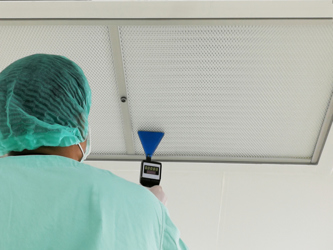How Tech Can Improve Air Quality In Hospitals
By Kayla Matthews, Productivity Bytes

Managing air quality in hospitals can be challenging due to the wide range of pollutants — like pathogens, chemical compounds and dust — that HVAC systems need to handle.
How can cleaning staff and machinery adequately control invisible fumes from hand sanitizer or debris from renovation projects? Even nice smelling bathroom sprays can have adverse effects. Unfortunately, the cost of not properly managing the air can be steep — in some cases, it may have negative health impacts on patients and staff.
Fortunately, there are many different air quality engineering solutions that can help hospitals improve their atmospheres.
The Importance Of Hospital Air Quality
Research shows a significant correlation between indoor environmental quality (IEQ) and individuals' health and productivity. Poor air quality — and sub-par indoor ventilation — can cause acute respiratory illness (ARIs), trigger asthma symptoms and even lead to chronic conditions, like Sick Building Syndrome (SBS).
This relationship between health and air quality is especially vital in hospitals, where large numbers of sick patients — who can be especially vulnerable to disease and ARIs — are housed in close quarters. Nurses and other hospital staff are also at a high risk of developing respiratory infections, likely due to the heightened levels of pollutants and pathogens. Poor ventilation can make these problems worse.
For example, a study conducted in 2015 after the outbreak of Middle East Respiratory Syndrome (MERS) in South Korea found that inadequate ventilation can facilitate the spread of viruses, like the coronavirus that causes MERS. These viruses can transmit through the air via infectious aerosols created by patients' coughing or sneezing. If air ventilation systems do not capture these aerosols, the infection can spread rapidly, affecting patients, hospital visitors and, eventually, healthcare workers.
Hospital sanitation staff also tend to use strong disinfectants and cleaning materials, which can have an additional negative impact on the indoor environment. To make the problem worse, many patients are especially vulnerable to ARIs due to pre-existing respiratory illness, compromised immune systems or general ill health that can make it harder to fight off infections.
How Technology Can Improve Hospital Air Quality
Following indoor air quality standards — like ASHRAE guidelines 62.1 and 170 — can ensure hospitals have the right air quality ventilation in place. Certain practices, like regularly changing filters, also can provide a safe indoor environment. However, safe procedures and HVAC systems designed to follow industry standards may not capture all air pollutants. For some hospitals, advanced tech may be necessary to ensure everyone stays healthy.
Fortunately, with the right technology, hospitals can significantly improve air quality — potentially reducing the spread of disease and the frequency of ARIs in both patients and staff. For example, hospitals can consider using activated carbon filters in conjunction with more traditional HEPA filters. Activated carbon is effective at removing gases and odors from indoor air, something HEPA filters can't always do.
Air quality monitoring systems that track common hospital pollutants — like carbon dioxide, volatile organic compounds, and nitrous oxide — can provide staff with better information about indoor environmental traits. With this information, administrative employees can know which systems are most effective. These systems also can take advantage of new technology, like Internet of Things (IoT) sensors, to provide more frequent updates or better coverage of hospital air quality.
Central vacuum systems remove environmental contaminants by pulling them into a vacuum and venting them outside the building. Clinics and hospitals often use these machines as a central sanitizing solution, with tubing that connects various rooms and facilities. These devices run continuously while the building is occupied and can carry out many functions other than cleaning, such as paper dust collection, water filtration, food spill removal and more.
Hospitals also can consider air purifiers that use ultraviolet germicidal irradiation (UVGI). These systems use short-wave ultraviolet light to kill or deactivate airborne bacteria and other organic pollutants, like mold and certain viruses. They are effective at reducing fungal contamination and have been used to disinfect air contaminated with airborne pathogens, like drug-resistant tuberculosis. UV air purification systems are even more efficient with the use of titanium oxide photocatalysts, which degrade volatile organic compounds.
Improving Indoor Air Quality With The Right Tech
Maintaining indoor air quality can be difficult in hospitals. Air purification systems in these buildings face unique challenges — like concentrations of airborne pathogens and chemicals from cleaning materials — that can cause significant health issues if not managed.
Luckily, these organizations have access to advanced technology that can help maintain a healthy indoor environment. Carbon filters can catch odors and gases that standard HEPA filters can't. UVGI can kill or deactivate pathogens that aren't always detected by traditional purification systems. Plus, monitoring systems can provide administrative staff with better information about which pollutants aren't filtered out by existing air purification technology. These innovations ensure that patients and employees alike stay safe and healthy.
About The Author
Kayla Matthews is a MedTech writer whose work has appeared on HIT Consultant, Medical Economics and HITECH Answers, among other industry publications. To read more from Kayla, please connect with her on LinkedIn, or visit her tech blog at https://productivitybytes.com.
